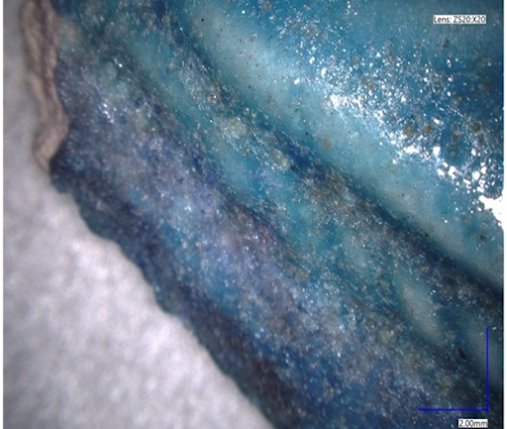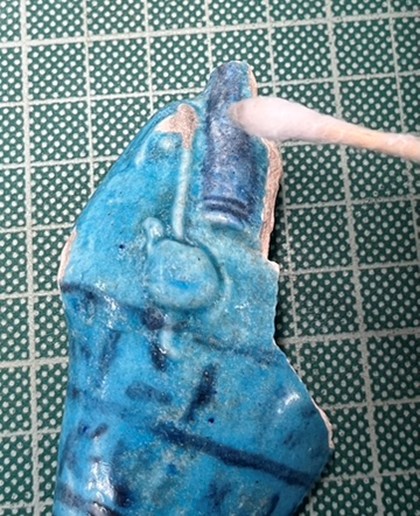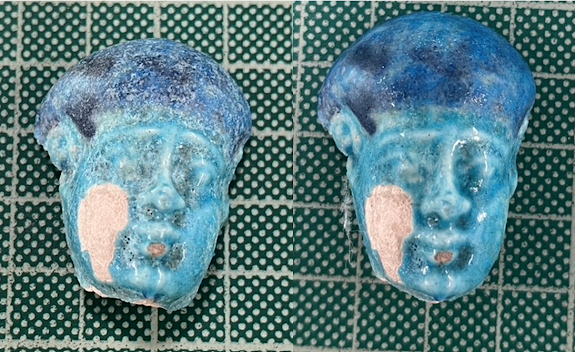This blog post has been written by Kayleigh Heister, a conservation student at Cardiff University. Before returning to university, Kayleigh worked for the National Trust for Scotland. She first came to the UK to complete her master’s degree in Heritage Management at Queen Mary University of London. Her main area of interest is wall painting conservation, but she is gaining practical experience with a wide variety of materials.
This blog post is written on my work restoring and conserving an ancient Egyptian shabti figure, which is on loan to the Egypt Centre from Harrogate Museums. When HARGM11044 first came to the Conservation Lab at Cardiff University in September 2024, it was in ten pieces (fig. 1).
 |
| Fig. 1: HARGM11044 before restoration |
Aside from reassembling the shabti, the surface of the faience needed to be
cleaned and inspected for any salt degradation and potential future risks for
damage. The faience itself was cloudy in appearance, specifically the face as
well as other areas of the body. Faience commonly suffers from salt degradation
due to how they are produced with salt in the glaze and ceramic body. Therefore,
the cloudy appearance could be due to salt buildup (fig. 2).
 |
| Fig. 2: Close-up of the glazed surface |
This necessitated further investigation using the
Keyence digital microscope, which provides a more magnified view of the
surface. Keyence revealed that it was not salt buildup, but rather a result of
the faience production. Dr. Ken Griffin informed me that the shabti dated to
the Ptolemaic Period (c. 305–30 BC). Shabtis during this period were
mass-produced, and the faience was made through the efflorescence method. This
means that the salts in the body would rise to the surface of the ceramic body
when fired to create the faience glaze. When it rose to the surface, bubbles
formed, and when the bubbles popped, it created a perfect little pocket that
minerals got stuck in (fig. 3).
 |
| Fig. 3: Close-up of the surface showing bubbles. |
A surprise find was four areas of old adhesive stuck
to the ceramic body, though there are no records of a previous break or repair.
The old adhesive had begun to flake and was easily removed with a pair of
tweezers. The reason for removal was to ensure that the new adhesive had better
contact with the ceramic body.
 |
| Fig. 4: Cleaning of the shabti surface |
The first step in the treatment plan was to clean the surface to determine if any minerals stuck in the faience or attached to the surface could be removed. Cleaning was done with a mixture of water and industrial methylated spirits. Some dirt was picked up on the swabs (fig. 4), and the appearance of the faience improved when wet (fig. 5). Once the surface was all cleaned, reassembly could begin.
 |
| Fig. 5: Before and after photos of the head |
The surface of
the ceramic next to where the shabti broke was primed with 10% Paraloid B-72 to
ensure that the adhesive could properly adhere to the surface and not fail.
After the primer was set, 30% Paraloid B-72 was used for a majority of the
pieces due to how big the gaps were between the joins. Three smaller pieces
were reattached with 10% Paraloid B-72 due to how clean the joins fit together.
Once the piece was reassembled and photos were taken (fig. 6), Ken was able to
read the hieroglyphs, which was one of the goals of the conservation treatment.
The shabti belonged to an individual named Djedher. The bichrome colour of the
glaze, particularly for the wig, resembles the shabtis of Petosiris, which were
excavated at Abydos (North Cemeteries, Cemetery G, tomb G50). It is therefore
likely that the shabti of Djedher also originates from this site (Janes 2012, 454–57).
 |
| Fig. 6: The restored shabti of Djedher |
Bibliography
De Regt, C. 2017. Conservation
issues related to Egyptian faience: a closer look at damaged shabti from the
Dutch National Museum of Antiquities. MPhil/MA thesis, University of
Amsterdam.
Florek, St. 2023. Egyptian
Faience. Available at: https://australian.museum/learn/cultures/international-collection/ancient-egyptian/egyptian-faience/.
[Accessed: 18 March 2025].
Janes, G. 2012. The shabti
collections 5: a selection from the Manchester Museum. Cheshire:
Olicar House.
National Trust. 2025. What is a
shabti? Available at: https://www.nationaltrust.org.uk/discover/history/art-collections/shabti-faqs.
[Accessed: 18 March 2025].
Nicholson, P. 1993. Egyptian
faience and glass. Princes Risborough: Shire.
Riccardelli, C. 2017. Egyptian faience:
technology and production. Available at: https://www.metmuseum.org/essays/egyptian-faience-technology-and-production.
[Accessed: 18 March 2025].
Smith, S. M. 1996. The manufacture
and conservation of Egyptian faience. ICOM Committee for Conservation 11th
Triennial Meeting. Edinburgh, 1–6 September 1996. London: James & James
(Science Publishers) Ltd.
TQ
ReplyDelete